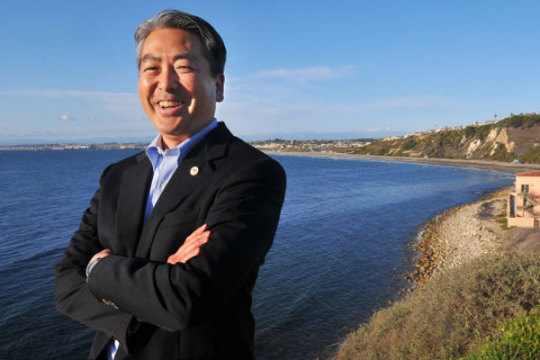
Candidate campaign page: http://www.alforassembly.com/
Residents of the South Bay are seeing a tight match in the June Primary between incumbent Assembly Member David Hadley and former Assembly Member Al Muratsuchi to represent Assembly District 66. Of the candidates, only Muratsuchi responded to CalBike’s survey to outline his platform on active transportation. Muratsuchi’s response was very encouraging, with a focus on reducing Vehicle Miles Traveled (VMT) to provide a more sustainable transportation system, and a commitment to fund active transportation programs to make cycling and walking more viable options for Angelenos. Muratsuchi also made it clear in his responses to CalBike that he recognizes that Southern California cannot solve its transportation challenges through freeway expansion, and notes his commitment to fund public transit as a component of a providing better transportation options. The South Bay deserves a candidate who will stand up for providing safe and efficient mobility options, and we are proud to endorse Al Muratuchi to help bring that positive change at the state level.
(See below for Al Muratsuchi’s full CalBike questionnaire response)
1. Do you ride a bicycle in your district and/or in Sacramento?
I did ride my bicycle before it got stolen in 2014. I look forward to taking back my bicycle and my assembly seat this year!
2. If yes, for what purpose(s) and how often? How do you most commonly commute to work?
Growing up bicycle riding was often my only mode of transportation. More recently I have ridden my bike as a family activity and for enjoyment.
3. If no, what would inspire you, and the 60% of people who are interested in riding, but concerned about safety to ride a bike for transportation?
Even though I answered that I do ride bicycles, I know that where I choose to ride or not ride today has to do primarily with traffic safety concerns. My favorite place to ride these days is along the beach bike path in the South Bay because it is completely isolated from car traffic. More opportunities need to be developed that give our community more options to choose bicycling for pleasure and transportation.
4. Would you commit to joining a group ride with local advocates along a route that illustrates the bicycle infrastructure conditions of the district you are running for?
Yes
5. Caltrans has established a goal to triple the number of bike trips by 2020. Do you support this goal?
Yes
6. Research has shown that the most effective way to boost the number of people bicycling is to create interconnected “complete bikeway networks” of physically protected bike lanes and traffic-calmed streets. The California Bicycle Coalition is seeking to create a new state program to provide large grants of $25-$50 million to build such networks in the communities which need it most. It will incentivize holistic planning of networks rather than piecemeal planning of one street at a time. Do you support using state funds for a competitive complete bikeway network grant program?
Yes
7. Do you support our complete streets provisions in SBX 1-1 of the special session to mandate the inclusion of “new bicycle and pedestrian safety, access, and mobility improvements” in every non-freeway road project funded by the state? It calls for sidewalks and protected bike lanes or bike paths in transit-dense areas on most roads with a speed limit over 25 miles per hour.
Yes
8. The Active Transportation Program (ATP), the sole state funding source for biking, walking, and safe routes to school improvements, was created by the Brown administration in 2013 with the stated intention to increase it continually. However, the Governor’s latest budget proposes no increase for the third straight year. Current funding levels on a per capita basis place California in the middle of the pack among states who provide dedicated active transportation funding. To reflect Caltrans’ goal to triple biking and double walking trips by 2020, do you support doubling the ATP?
Yes
9. Bike sharing programs are spreading throughout California, but they often do not reach low-income neighborhoods. Do you support providing state funds to allow these programs to serve all Californians who could reasonably benefit, in the same way that public transit serves the public?
Yes
10. About 3,000 people are killed on California streets every year. Do you support a “Vision Zero” goal of zero traffic fatalities by a certain date?
Yes
11. The California Air Resources Board estimates that 38% of California’s 447 million metric tons of carbon emitted every year comes from the transportation sector, which along with other emissions, results in thousands of deaths and millions of dollars in wasted health care spending. What do you feel are the three most important actions the state should take to reduce carbon emissions from transportation?
A. . Incentivize the use of non-fossil fuel vehicles.
B. Invest in public transportation infrastructure including bicycle support facilities.
C. Reduce Vehicle Miles Traveled through complete street programs and other smart redevelopment planning while encouraging a shift of state and local road subsidies to cost-of-driving (VMT fees).
12. Should cap-and-trade funds be used for highway congestion relief projects that expand road capacity?
No
13. If you could send out one tweet to the bike community that you think would win over their support, what would it say?
Vote by bike on June 7th and together our critical mass of action will build more bicycles paths to keep us rolling forward. #bikethevoteCA
14. Do you have any other comments or questions about how you have supported or would support the California Bicycle Coalition’s mission of enabling more people to bicycle for healthier, safer, and more prosperous communities for all?
I supported Measure R and I will support Measure R2. My opponent, the current incumbent, opposes these public transportation funding measures.
